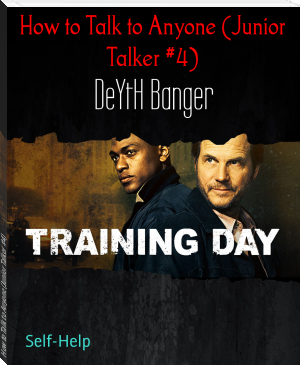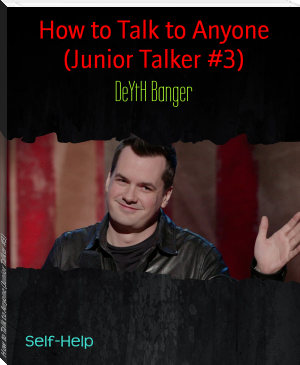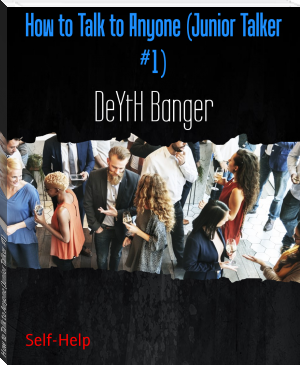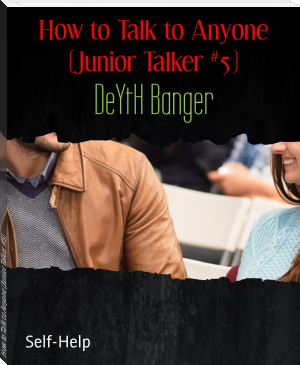How to Talk to Anyone (Junior Talker #2) by DeYtH Banger, Clive Cooper (epub ebook reader .txt) 📕

- Author: DeYtH Banger, Clive Cooper
Book online «How to Talk to Anyone (Junior Talker #2) by DeYtH Banger, Clive Cooper (epub ebook reader .txt) 📕». Author DeYtH Banger, Clive Cooper
Yes, a person can overdose on heroin. A heroin overdose occurs when a person uses enough of the drug to produce a life-threatening reaction or death. Heroin overdoses have increased in recent years.3
When people overdose on heroin, their breathing often slows or stops. This can decrease the amount of oxygen that reaches the brain, a condition called hypoxia. Hypoxia can have short- and long-term mental effects and effects on the nervous system, including coma and permanent brain damage.
How can a heroin overdose be treated?
Naloxone is a medicine that can treat an opioid overdose when given right away. It works by rapidly binding to opioid receptors and blocking the effects of heroin and other opioid drugs. Sometimes more than one dose may be needed to help a person start breathing again, which is why it’s important to get the person to an emergency department or a doctor to receive additional support if needed. Read more in the Substance Abuse and Mental Health Services Administration’s Opioid Overdose Prevention Toolkit.
Naloxone is available as an injectable (needle) solution, a handheld auto-injector (EVZIO®), and a nasal spray (NARCAN® Nasal Spray). Friends, family, and others in the community can use the auto-injector and nasal spray versions of naloxone to save someone who is overdosing.
The rising number of opioid overdose deaths has led to an increase in public health efforts to make naloxone available to at-risk persons and their families, as well as first responders and others in the community. Some states have passed laws that allow pharmacists to dispense naloxone without a prescription from a person’s personal doctor. Read more about naloxone at our Naloxone webpage.
Photo by ©iStock.com/KatarzynaBialasiewiczIs heroin addictive?
Heroin is highly addictive. People who regularly use heroin often develop a tolerance, which means that they need higher and/or more frequent doses of the drug to get the desired effects. A substance use disorder (SUD) is when continued use of the drug causes issues, such as health problems and failure to meet responsibilities at work, school, or home. An SUD can range from mild to severe, the most severe form being addiction.
Those who are addicted to heroin and stop using the drug abruptly may have severe withdrawal. Withdrawal symptoms—which can begin as early as a few hours after the drug was last taken—include:
restlessness severe muscle and bone pain sleep problems diarrhea and vomiting cold flashes with goose bumps ("cold turkey") uncontrollable leg movements ("kicking the habit") severe heroin cravings
Researchers are studying the long-term effects of opioid addiction on the brain. Studies have shown some loss of the brain’s white matter associated with heroin use, which may affect decision-making, behavior control, and responses to stressful situations.4–6
How is heroin addiction treated?
A range of treatments including medicines and behavioral therapies are effective in helping people stop heroin use. It’s important to match the best treatment approach to meet the particular needs of each individual patient.
Medicines include buprenorphine and methadone. They work by binding to the same opioid receptors in the brain as heroin, but more weakly, reducing cravings and withdrawal symptoms. Another treatment is naltrexone, which blocks opioid receptors and prevents opioid drugs from having an effect. A NIDA study found that once treatment is initiated, both a buprenorphine/naloxone combination and an extended release naltrexone formulation are similarly effective in addiction. Because full detoxification is necessary for treatment with naloxone, initiating treatment among active users was difficult, but once detoxification was complete, both medications had similar effectiveness.
Behavioral therapies for heroin addiction include methods called cognitive-behavioral therapy and contingency management. Cognitive-behavioral therapy helps modify the patient’s drug-use expectations and behaviors, and helps effectively manage triggers and stress. Contingency management provides motivational incentives, such as vouchers or small cash rewards for positive behaviors such as staying drug-free. These behavioral treatment approaches are especially effective when used along with medicines.
How many teens use tobacco and nicotine products?
Smoking and smokeless tobacco use generally start during the teen years. Among people who use tobacco:
Each day, nearly 3,200 people younger than 18 years of age smoke their first cigarette.13 Every day, an estimated 2,100 youth and young adults who have been occasional smokers become daily cigarette smokers.14 If smoking continues at the current rate among youth in this country, 5.6 million of today’s Americans under the age of 18 - or about 1 in every 13 young people - could die prematurely (too early) from a smoking-related illness.15 E-cigarettes are the most commonly used form of tobacco among youth in the United States. Young people who use e-cigs or smokeless tobacco may be more likely to also become smokers.16, 17 Using smokeless tobacco remains a mostly male behavior. About 490,000 teens ages 12 to 17 are current smokeless tobacco users. For every 100 teens who use smokeless tobacco, 85 of them are boys.18
A survey of teens in the United States shows cigarette smoking is on the decline. That could be in part due to the introduction of e-cigarettes. Teens today are more likely to smoke an e-cigarette than a regular cigarette.19
Below is a chart showing the percentage of teens who use tobacco and nicotine products:
Swipe left or right to scroll.
Monitoring the Future Study: Trends in Prevalence of Various Drugs for 8th Graders, 10th Graders, and 12th Graders; 2017 (in percent)* Drug Time Period 8th Graders 10th Graders 12th Graders Cigarettes (any use) Lifetime 9.40 15.90 26.60 Past Month [1.90] 5.00 9.70 Daily [0.60] 2.20 4.20 1/2-pack+/day 0.20 0.70 1.70 Smokeless Tobacco Lifetime 6.20 9.10 [11.00] Past Month [1.70] 3.80 [4.90] Daily 0.40 0.60 2.00 Any Vaping Lifetime 18.50 30.90 35.80 Past Year 13.30 23.90 27.80 Past Month 6.60 13.10 16.60
* Data in brackets indicate statistically significant change from the previous year.
Chapter 8 - Fuck You
- This chapter is not so serious!
Effects of Alcohol on Brains and Bodies
These are just some of the problems alcohol can cause:
Alcohol Poisoning
You can die from drinking a lot of alcohol at one time.
Diseases
Heavy drinking over the years can raise your risk for stroke (brain injury from a blood clot), cancer, liver disease, and other illnesses. People can forget to use condoms when they're drunk, have unsafe sex, and get HIV/AIDS or hepatitis (a liver disease).
Hurts the Baby
If a pregnant woman drinks alcohol, it can cause brain damage, which can lead to other health problems in the baby.
You Can Get Hurt or Killed
Being drunk makes you more likely to get hurt or killed. Alcohol is involved in:
60 percent of drownings, murders, and deadly burns 50 percent of severe injuries and sexual attacks 40 percent of deadly driving crashes, deadly falls, and suicides
Brain Damage
Long-term alcohol abuse can permanently hurt your brain cells. This can make it hard to walk, remember, or learn new things.
Addiction
You can get addicted to alcohol just like other drugs. Fortunately, there are medicines and other treatments that can help someone recover from alcohol addiction.
©istock.com/aijohn784 Being drunk makes you more likely to get hurt or killed. Alcohol is involved in many deadly car crashes.
- I love people when they abuse alcohol
...
Look Before and After... before.... normal human... then after aka ... it's zombie
Effects of Meth on Brains and Bodies
These are just some of the problems meth can cause:
You Overheat
Meth can make your body temperature so hot that you pass out. Sometimes this can kill you.
Crank Bugs
Meth can make you feel like bugs are crawling on or under your skin. It makes you scratch a lot. Scratching causes sores on your face and arms.
Meth Mouth
People who use meth break, stain, or rot their teeth. They often drink lots of sweet things, grind their teeth, and have dry mouth. This is called "meth mouth."
You Look Old
People who use meth start looking old. They burn a lot of energy and don't eat well. This can make them lose weight and look sick. Their hands or body might shake. Their skin looks dull and has sores and pimples that don't heal. Their mouth looks sunken as the teeth go bad.
HIV/AIDS, Hepatitis
People who inject (shoot up) meth can get HIV/AIDS or hepatitis (a liver disease) if they share used needles. People also get these diseases by having unsafe sex. They often forget to use condoms because they're high on the drug.
Addiction
Meth use can quickly lead to addiction and hurt different parts of your brain. It can cause thinking and emotional problems that don't go away or that come back again even after you quit using the drug. For instance, you might feel, hear, or see things that aren't there. You might think that people are out to get you or start believing strange ideas that can't really be true.
Pain Medicine (Oxy, Vike) Facts
Pain medicines relieve pain from surgery or injuries. You need a doctor's note (called a prescription) to buy some strong kinds of these medicines. Prescription pain medicines are legal and helpful to use when a doctor orders them to treat your medical problem.
But people sometimes take these without a doctor's prescription to get high or to try to treat themselves or their friends. Drug dealers sell these pills just like they sell heroin or cocaine. Some people borrow or steal these pills from other people.
Some people think that prescription pain medicines are safer to use than "street" drugs because they are medicines. Prescription pain medicine use can be as dangerous as heroin or cocaine use.
Oxycodone is one pain medicine that people often abuse. Sometimes it goes by the brand names OxyContin® or Percocet®. Another one that is often abused is hydrocodone. One of its brand names is Vicodin®.
Pain medicines are usually white, round, or oval pills. They can be taken whole, smoked, or crushed into a powder that is snorted or injected.
Like heroin, pain pills can cause a rush of good feeling when they're first taken, but they can also make you want to throw up. They can make you very sleepy. And you can get addicted to them.
Some slang names for oxycodone are:
Oxy Cotton Percs
Some slang names for hydrocodone are:
Vikes Vikings
Effects of Pain Medicine Abuse on Brains and Bodies
These are just some of the problemspain medicine abuse can cause:
You Stop Breathing
Pain medicine abuse can slow down or evenstop your breathing.
Coma
Pain medicine abuse can put you in a coma.That's when nothing can wake you up.
Addiction
Prescription pain medicines can be as addictive as heroin—especially if they are smoked orinjected. Then, even if you get treatment, it's hard to stay away from the drug. Fortunately,there are medicines that can help someone recover from prescription pain medicineaddiction.
Overdose
Signs of a pain medicine overdose are cold and sweaty skin, confusion, shaking, extremesleepiness, trouble breathing, and coma.
Death
Many people die from pain medicine overdoses. In fact, more people overdose from painmedicines every year than from heroin and cocaine combined.
Coping With Stress Without Smoking
Stress is a normal part of life—in moderation it can help you reach your goals, but too much stress creates more problems. Managing stress is a key part of quitting smoking.
You may have learned to deal with stress by smoking. But there are ways to handle stress without smoking. Here are a few ideas you might find helpful. Some of these tips may take practice, but others you can do right away. Try one or more to learn what works for you.
Relax
Our bodies respond to stress by releasing hormones that increase your heart rate and raise your blood pressure. Practicing relaxation techniques, like the ones below, may improve your health and help you handle your stress in positive ways.
Breathe
Take a few slow, deep breaths—in through your nose, out through your mouth. You will feel your body start to relax.
Locate Your Stress
Take a minute to figure out how





Comments (0)